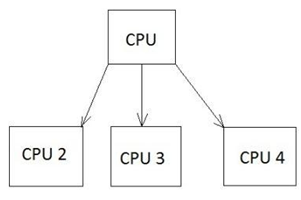Python Forensics-다중 처리 지원
법의학 전문가들은 일반적으로 일반적인 범죄에서 디지털 증거를 분석하기 위해 디지털 솔루션을 적용하기가 어렵다는 것을 알게됩니다. 대부분의 디지털 조사 도구는 단일 스레드이며 한 번에 하나의 명령 만 실행할 수 있습니다.
이 장에서는 일반적인 포렌식 문제와 관련 될 수있는 Python의 다중 처리 기능에 초점을 맞출 것입니다.
다중 처리
다중 처리는 둘 이상의 프로세스를 지원하는 컴퓨터 시스템의 기능으로 정의됩니다. 다중 처리를 지원하는 운영 체제를 사용하면 여러 프로그램을 동시에 실행할 수 있습니다.
다음과 같은 다양한 유형의 다중 처리가 있습니다. symmetric 과 asymmetric processing. 다음 다이어그램은 일반적으로 법의학 조사에서 따르는 대칭 다중 처리 시스템을 나타냅니다.

예
다음 코드는 Python 프로그래밍에서 내부적으로 서로 다른 프로세스가 나열되는 방식을 보여줍니다.
import random
import multiprocessing
def list_append(count, id, out_list):
#appends the count of number of processes which takes place at a time
for i in range(count):
out_list.append(random.random())
if __name__ == "__main__":
size = 999
procs = 2
# Create a list of jobs and then iterate through
# the number of processes appending each process to
# the job list
jobs = []
for i in range(0, procs):
out_list = list() #list of processes
process1 = multiprocessing.Process(
target = list_append, args = (size, i, out_list))
# appends the list of processes
jobs.append(process)
# Calculate the random number of processes
for j in jobs:
j.start() #initiate the process
# After the processes have finished execution
for j in jobs:
j.join()
print "List processing complete."여기에서 기능 list_append() 시스템의 프로세스 집합을 나열하는 데 도움이됩니다.
산출
코드는 다음과 같은 출력을 생성합니다.
